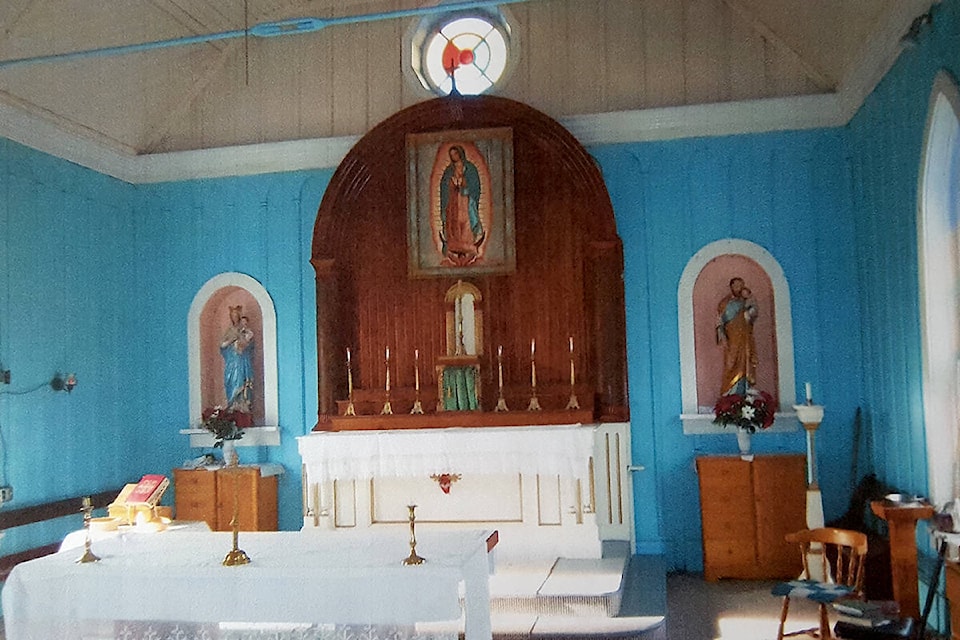Barry SALE
Special to the Tribune
When you turn off Highway 97 to the entrance of the Sugar Cane Reserve, the first thing you see is a bright red and white church steeple and bell tower.
These belong to the Church of the Immaculate Conception, a beautiful, old historic building located on the south side of the original village square.
For well over 100 years now, this impressive structure has been a gathering place for the community’s important spiritual and cultural events.
In the Cariboo in the late 1800s, the Roman Catholic Order of Mary Immaculate (OMI) priests were very active in their missionary work among the local Indigenous bands.
Two of the most noteworthy were Father Jean-Marie Le Jacq, who was based at St. Joseph’s Mission from 1868 to 1873, and again from 1891 to 1898; and Father Francois Marie Thomas, who arrived in 1897 and spent almost 60 years in the Cariboo and the Chilcotin.
Both of these men earned respect and deep regard from all the First Nations groups in the area, and both were dedicated to advocating for, helping and ministering to these people.
Read More: William Pinchbeck is not alone on the hill
By 1892, Sugar Cane was a well established village of the Secwepemc people, having been officially created in 1884.
There were over 100 people living there, and the OMI Fathers felt that it was important to have a church built as a focus point for worship.
Plans were made and money was found, so that in 1894 the church could be constructed.
It was formally dedicated and officially opened in July of 1895, replacing a roughly built log structure, covered clapboard siding.
This brand new church was “state of the art,” and it has remained in continuous use since the day it was opened.
The outward appearance of this church is in the Gothic style, with a vaulted ceiling and a flared roof.
It appears very similar to any parish church in the Eastern Townships of Quebec, reflecting the fact that most of the priests involved with the planning and construction were French Canadian, and used traditional plans similar to those of their home churches.
The outside of the building feature fitted wooden siding, a cedar shake roof, an arched entranceway with stained glass windows, and the prominent steeple and bell tower.
Inside, there was a choir loft above the entrance, arcaded board and batten panelling on the walls, a stained and painted wooden altar flanked by recessed alcoves with figures of Mary and Joseph, and cedar pews with kneeling benches.
Two circular rose motif windows of red, yellow, blue and white glass were located at each end, high up near the vaulted ceiling.
Ever since its inception, this church has shown the influences of the Shuswap culture in its bright colours and Secwepemc designs.
A large, wood stove was located on the north wall. Since all the walls were insulated with sawdust, it was always a challenge to keep the building evenly warm, especially in the winter. Over the years, several minor changes have been made.
The stove has been upgraded. The original pews were replaced with the pews from the chapel at St. Joseph’s Mission after it closed in1981.
The placement of the altar has been changed, as it was in all Catholic churches.
However, by and large, this church has changed little since it was first opened.
In 2013, the Williams Lake Indian Band applied to the B.C. Heritage Trust and received a grant and the band matched the funds to completely renovate the church.
The foundation was shored up, work was done on the roof, stain glass windows were reparied, additional insulation was put in and electric heat.
Before it was only heated by a wood stove, which is still used.
The chimney was redone and hardwood birch flooring was installed.
A woodworker in the community built framing for an Immaculate Conception picture to replace the original image that had disappeared years ago.
A tabernacle lamp that hung from a chain in the ceiling by a pully system that also disappeared, was acquired by an E-bay bid to the Netherlands.
The lamp was from the same era, but they had it electrified.
The confessionals were reworked, recessed lighting was installed in some areas, and they painted.
They replaced all the ‘Immaculate Conception,” blue and it brought out all the architectual detail.
At the time they were doing the reonvations, Pioneer Log Homes donated and built a gazebo adjacent to the church with a washroom, which the church never had.
The building is dedicated to Pioneer Log Homes owner Bryan Reid Sr.’s mother Anna Crucil.
Meanwhile, the Church of the Immaculate Conception continues to stand, stately and serene, occupying a dominant position in the Sugar Cane village, just as it has done for the past 125 years.
Do you have a comment about this story? email:
editor@wltribune.com
Like us on Facebook and follow us on Twitter.
